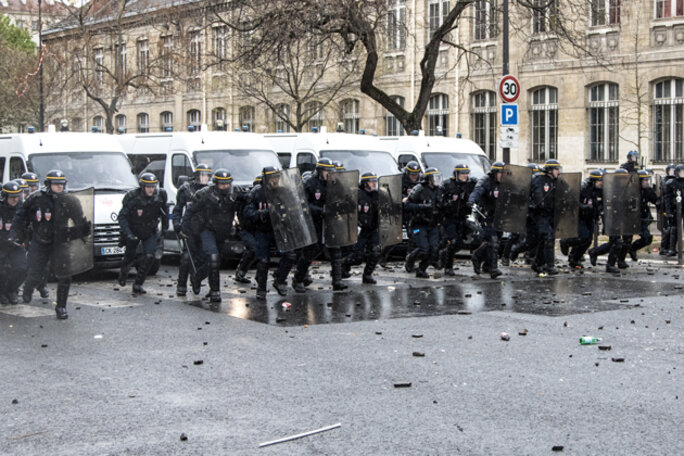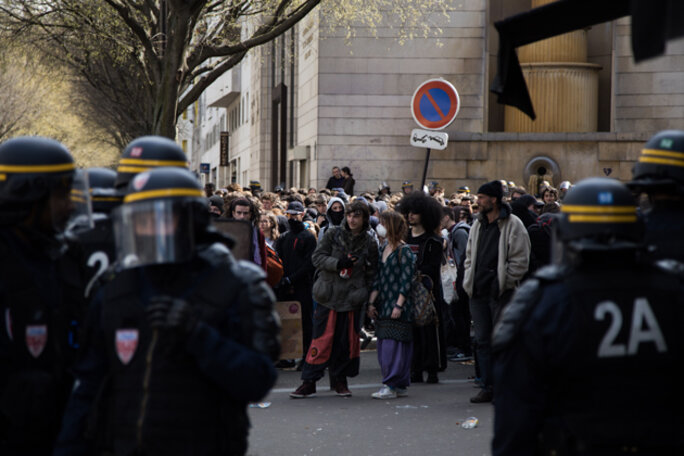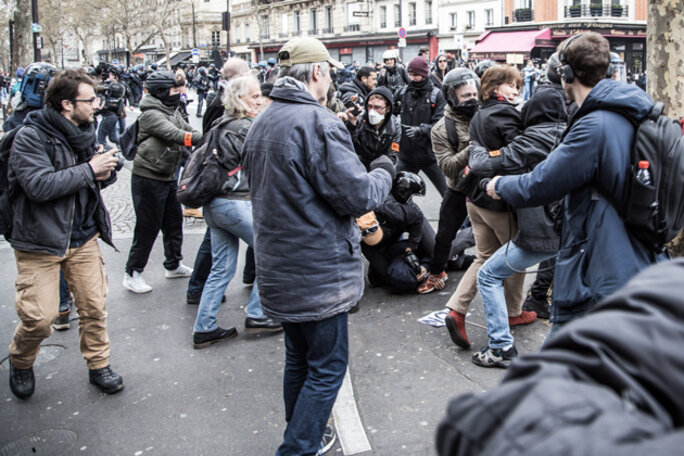For the last 18 months or so there has been something of a love-hate relationship between the French public and the forces of law and order. In November 2014, after the death of protester Rémi Fraisse at the hands of a gendarme grenade at Sivens in south-west France, the gendarmerie was vilified. But in January 2015 police and gendarmes were widely praised for the way they took down the killers behind the Charlie Hebdo massacre and the kosher supermarket hostage tragedy in Paris, attacks in which the police were also victims.
Then earlier this month the Info'Com union, which is affiliated to the powerful CGT union and represents workers in the press, PR and publishing industries, published a poster on its website showing a police baton, a CRS riot police badge and a pool of blood. The headline read: “The police should protect citizens, not hit them.”
This image, a reference to incidents of police violence during recent protests by young people against planned labour law changes, sparked an angry reaction, not least from interior minister Bernard Cazeneuve. He denounced what he called a “shocking” campaign that “seriously implicates the national police”. The main police trade union, SCSI-CFDT, attacked a “shameful poster” which was an “insult to the thousands of police officers and gendarmes wounded in the line of duty”. Another police union, Synergie, called on the Ministry of the Interior to make a formal legal complaint against what it called a “contemptible incitement to hatred” and “violence” against the forces of law and order.
On the protesters' side, the tension has been heightened since the broadcast of a video in which a police officer was seen punching a 15-year-old secondary school pupil from the lycée Henri-Bergson in Paris on the fringes of a protest against the proposed labour law reforms on March 24th. The officer in question, a 26-year-old police constable, will be tried in May for “violence committed by a person in a position of public authority” against the school student. The officer was detained in custody by the Inspection Générale de la Police Judiciaire (IGPN), the body that polices the police.
Despite the swift action taken to prosecute the police constable, the damage has been done. Especially as the parents' federation the Fédération des Conseils de Parents d’Élèves (FCPE) has produced a second video of police violence near the school, while there has also been talk of other incidents on social networks and in the media. Activist websites such as Rebellyon and Paris-luttes.info have even been drawing up a list of police misconduct and are giving advice to those who are accused of having attacked law enforcement officials themselves.
In the course of the protests Mediapart has gathered several accounts of behaviour that has gone well beyond the traditional maintenance of law and order. For example Félix, a secondary school pupil from Paris who insists that, at the beginning, he had “no hostility towards the forces of law and order” and who says he was “hit with a baton in the back”, describes what he calls the “rabid” behaviour of the CRS riot police.

Enlargement : Illustration 2

There have also been numerous incidents in the city of Rennes in western France. According to local unions the protests held there on March 31st and April 9th provoked a completely disproportionate reaction from the forces of law and order. “Nearly 1,000 tear-gas grenades were thrown at demonstrators and even passers-by, with the aim of barring the protesters' access to the city centre. The [riot officers] made unrestrained and dangerous use of Flash-Ball [rubber] rounds. Some stun grenades were also used,” said the local Ile-et-Vilaine branch of the CGT trade union. Another union, Sud-Santé Rennes, made similar comments.
Around ten protesters are meanwhile facing criminal proceedings for having “taken part in an armed gathering” and for having “thrown projectiles at the forces of law and order” on March 31st. One of the accused is a 60-year-old trade unionist who insists – and there is video footage to back his claim – that he fell down with a Sud-Santé flag in his hand as he tried to flee and that while on the ground he was hit several times by police officers who were charging down the street.
Following the protest on April 9th two protesters were hurt to the extent that they had to be signed off work, one for 90 days and the other for 21 days. “We joined the procession of protesters heading to place de Bretagne in Rennes on Saturday at around 2pm when some CRS descended on us as we reached the Arcades de République. There was no one around us. There were four or five CRS, they separated us then hit and insulted us,” the young couple told Ouest-France newspaper.
There have been so many recurring tensions between demonstrators and the police since the start of the movement against the labour reforms that the question arises as to whether there has been a deliberate desire to let the protests degenerate into trouble. For example, on April 14th, the start of the Paris protest march was fixed for place de Stalingrad in the 19th arrondissement or district of Paris. School pupils had planned a gathering a little earlier in the morning. This group of school students was encircled and held in place, stopped from going down avenue Jean-Jaurès to join the rest of the procession and thus allowing the demonstration to begin. In the meantime there were violent exchanges. Some demonstrators cried: “Free our comrades.” At the slightest sign of movement the CRS charged, used their batons and tear-gassed the blocked youngsters. Bottles, stones and even chairs taken from the terraces of adjacent cafés were thrown at the police by the visibly infuriated demonstrators.

Enlargement : Illustration 3

During this demonstration, which was modest in terms of participation, two lines of CRS police encircled the procession itself, stopping people from entering or leaving. Beforehand the organisations involved, in particular student and school pupil groups, had informed the authorities that the march would go from the place de la Bataille de Stalingrad to place de la Bastille. Just before the place de la République the crowd came to a halt. When it arrived at the place de la République the demonstration was dispersed with tear gas and sting grenades. The crowd began to choke as the square was covered with a grey cloud, though the majority of the protestors managed to seek refuge in adjacent streets. The protesters used distilled water to sooth there eyes, which was handed out by CGT officials to those who had not thought to bring their own.
Pauline, aged 20, and a student at the Sciences-Po history faculty in Paris, joined the protest when it arrived at place de la République. From a distance the student said she thought that it was a “CRS demonstration” that was taking place. The heavy police presence worried her as did the random nature of the charges. “They can just decide that your face doesn't fit. At the start I thought that I wasn't risking anything because I wasn't provoking them. But in fact that doesn't make any difference.”
Police equipped with cameras to protect themselves from accusations
The Solidaires trade union has raised questions about the “instructions given to the forces of law and order”, highlighting the fact that “several interventions have taken place involving plain-clothed police using union stickers and without police armbands”. The union says: “The Paris inter-union group moreover wrote to the Paris police prefecture [editor's note, the police authority in Paris] on April 11th to ask for a meeting to go over recurring problems with the control of demonstrations by the forces of law and order. This letter [signed by the] CGT-FO-Solidaires-UNEF is quite unusual in noting a real climate of repression.” Jean Vigne, secretary-general of the Sud-Santé union, speaks ironically about the police officers “disguised” as union officials. “You can spot them: they all wear the same grey Quechua backpacks!”

Enlargement : Illustration 4

In a leaflet distributed in the middle of April the CGT-Police union branch itself showed surprise at some of the methods deployed for maintaining law and order at the Paris protests on April 9th. “All the forces involved had been informed over the radio that at the front of the procession a meeting point for violent activists was located at boulevard du Temple with a van with a 'pirate' flag,” said the police union. “The authorities had let the demonstration leave [place de la] République despite the presence of violent hooded anarchist groups … police officers were not authorised (and were not given the means) to intervene to protect the peaceful demonstrators, the shopkeepers, colleagues, property and a police station.” The union concluded that by “choosing to re-establish order by force, rather than to remove as quickly as possible the disruptive elements” the authorities were using a “tactic” that favoured misconduct, including by police officers, and meant that one did not have a “fundamental debate on choices [made by] society”.
Contacted by Mediapart, the CGT-Police secretary-general, Alexandre Langlois, explained why his colleagues were unhappy. “It's bit of a caricature [but] we join the police to defend widows and orphans. That's not what we're being asked to do here at all. Everything's in place for things to go wrong. For example, we moved a unit of CRS who were easily able to stop a group of identified troublemakers who were going one evening to the Nuit Debout [protest]. For the first time the authorities told us that evening: 'Let them pass!' On the other hand, the means were put in place to ensure the protection of the prime minister's [editor's note, Manuel Valls] home...”
A police source suggests that the force's hierarchy is completely disorganised. The state of emergency, which has been in place since the November 13th attacks, has obliged the authorities to deploy forces in place de la République for the Nuit Debout protest and during the anti-labour law demonstrations that have taken place each week across France since March 9th. There is a real fear of an attack at place de la République and the police officers who are carrying out investigations into potential attacks are sometimes called upon to keep law and order or infiltrate the demonstrators.
Philippe Capon, from the UNSA-Police union, says the current protests are “difficult” to police. “We're not seeing here traditional social movements with the [union] confederation stewards supervising and the police as a second line,” he said. “Here we find ourselves in the front line, contact is very often very violent and that can indeed get out of control. According to my figures we already have close to 200 officers wounded since the start.”
According to Mediapart's information, none of the officers under the spotlight in various proceedings is pleading fatigue brought on by the fact that they have been on permanent call to the public authorities since the attacks of January 2015. But all say they are fed up with being depicted as “counter-demonstrators” or “supporters” of the labour reform bill. “We're citizens like anyone else,” is in essence their argument, based on several sources Mediapart has spoken to. “We're just there to maintain order, independent of our political ideas.”
For their part, the prosecution authorities in Paris note that only two criminal proceedings are under way for “violence committed by a person in a position of public authority”. These are the two that relate to events outside the lycée Henri-Bergson in Paris. But every day there are investigations related to “violence committed against a person in a position of public authority”. A 25-year-old man was also sentenced on April 13th to a year's imprisonment, six months of which were suspended, for having seriously injured a gendarme in the eye by throwing a firecracker in his face.
As for the body that polices police conduct, the IPGN, as of Friday April 15th it had received just 12 referrals since the start of the social movement. Its officers, who are not known for being particularly tender towards their colleagues, insist that allegations of “use of disproportionate force” are no more numerous than they were during the marches against same-sex marriage, the anti-carbon tax demonstrations in Brittany and pro-Palestinian protests. “The data is relatively comparable, there is no exponential growth,” said a source. In other words there has apparently been no more misconduct during these demonstrations than during the last social movements of similar scale or intensity.
🔴[#VIDÉOCHOC]#FRANCE : Un policier en civil va jusqu'à frapper à coup de matraque le visage d'un lycéen... pic.twitter.com/Tir5i4VH6l
— LIES BREAKER (@Lies_Breaker) 24 mars 2016
However, one phenomenon is new, and that is that more and more police officers are employing GoPro cameras for their own personal use. “The public have the right to film the police on the public highway but the police also have the right to film the public,” a police superintendent points out. The aim is for officers to be able to protect themselves should they face accusations of misconduct.
“Images rule,” says one police sergeant. “And what circulates on social networks can be incomplete, subject to dishonest interpretation. Sometimes it's even done in good faith. For example, concerning the second video at the lycée Bergson, the one where you see a hooded policeman in plain clothes striking blows on the backs of secondary school pupils with a tonfa. The image gives the impression of violence, I was myself convinced that I was seeing something very serious. The alleged victims of this police officer have been questioned and all confirm that he didn't hit them. It's an optical illusion...” When contacted, the Paris prosecution authorities said they were unaware of this version of the events.
In any case, it is clear that the police approach is changing on the issue of violence. After the Paris protests on March 31st, the police authorities released its own video to various media (including Mediapart) showing the violence of troublemakers who cornered some police officers and sought confrontation. It was an attempt to use images to put into context the accusations of police violence.
In recent years, however, France has come under fire from Amnesty International over the question of police violence and in particular how such incidents are followed up. “The impartiality and the exhaustiveness of the investigations carried out by the judicial authorities remain a source of concern,” the human rights group said in a statement in 2015.
--------------------------------------------------------------------------
- The French version of this article can be found here.
English version by Michael Streeter


